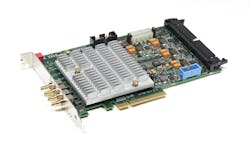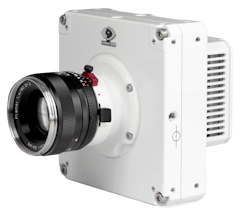BitFlow Frame Grabber Compatible with Vision Research Camera
After performing a series of tests, Vision Research verified that BitFlow’s Cyton-CXP4 CoaXPress frame grabber is compatible with Vision Research’s Phantom S990 camera, according to a news release from BitFlow.
The high-speed camera delivers direct data transfer speeds of 70 Gbps, streaming a maximum of 937 fps at 4096 x 2304 (8 bit), or up to 680,000 fps at lower resolution settings.
To achieve that throughput, the Phantom S990 applies a process it dubs "stitching" that divides transmitted images by rows, interleaves the images as they arrive in the frame grabber, and then applies a simple algorithm to "stitch" them back together. While stitching helps the camera realize high speeds, it also saps the host PC of considerable computing resources, often slowing down processing times.
Another issue with high-throughput cameras, like the Phantom S990, is "thrashing," which occurs when the volume of incoming frames outpaces the CPU of the host PC. Thrashing typically happens at extremely high frames rates, usually 20,000 fps or more.
Frame grabbers address both issues, BitFlow says.
During testing to verify compatibility, Vision Research used Cyton CXP4 four-lane frame grabbers configured to achieve a total of 16 CXP-6 single-links. The Cyton CXP4’s direct memory access engine (DMA) performed re-interleaving of lines on the fly without any CPU usage, an advantage when the Phantom S990 is running in two- or four-bank mode and outputting interleave "chunks" of lines simultaneously to each connected frame grabber.
In the first test, a single Cyton CXP4 was installed in a host PC's PCIe slot connected by four cables to the camera. This is not the ideal for optimal performance of the Phantom S990, since it only allows for one fourth of the maximum fps, BitFlow says. However, the Cyton CXP4's Single Frame Grabber Mode allowed for fast configuration and camera focusing via live video provided by running BitFlow Preview software.
Next, four Cyton CXP4 frame grabbers were installed in the PCIe slots. However, each frame grabber was viewed by the operating system as four Virtual Frame Grabbers (VFGs). After the order of the frame grabbers was determined—a process that simplifies cable connections—the overall system was configured and tested in Four Frame-Grabber Mode by running BitFlow Preview four times.
System testing was performed using BitFlow2x, an application designed to acquire images from one or four frame grabbers simultaneously.
For more information, visit www.bitflow.com and www.phantomhighspeed.com.

